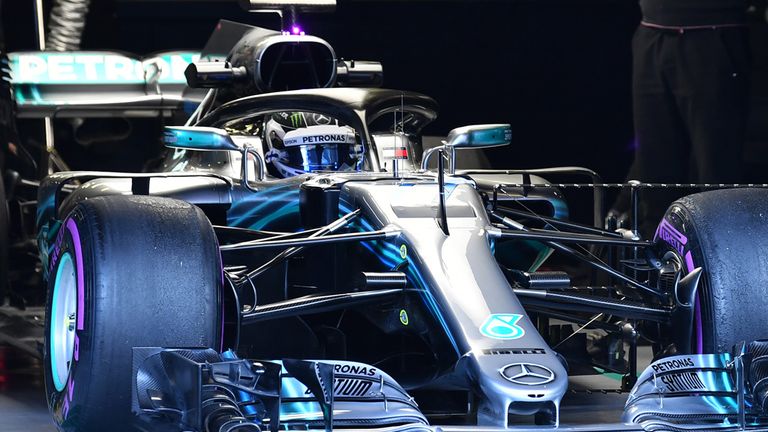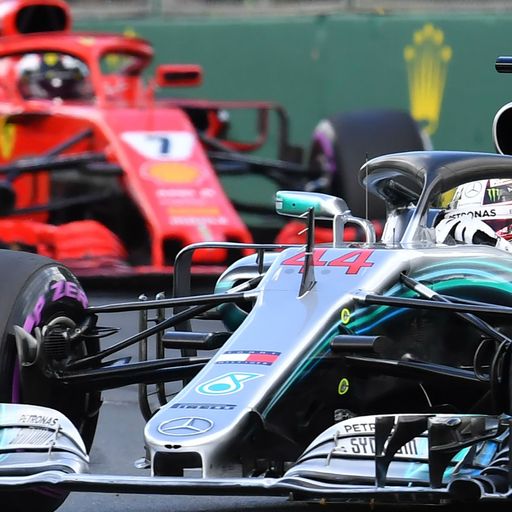What's wrong with the Mercedes?
Sky F1 analyst Mark Hughes assesses the fluctuating form of the 2018 Mercedes car and the extent of the world champions' potential problems...
Tuesday 11 December 2018 14:53, UK
Never in the hybrid era had Mercedes been beaten for three consecutive races.
It begs the question of which of three possible scenarios apply.:
1) Have Mercedes created another diva?
2) Is it actually worse than that and the W09 is just intrinsically slower than its competition?
3) Is it neither of those and it's actually still the inherently fastest car merely compromised by two consecutive tricky sets of circumstances in Bahrain and China?
To put the questions into perspective, with just a different throw of the Safety Car dice, we could easily be looking at Mercedes having won two of the opening three races and such questions wouldn't be getting asked. It's even feasible that without those Safety Cars and Virtual Safety Cars, and without the Bahrain combination of tactical uncertainty and Bottas' caution, Merc could've won all three.
However, it all unfolded the way it did and so inevitably the questions are being asked. Furthermore, regardless of what element of bad luck has played out, certain difficulties with the W09 have been evident - i.e. even if they had won the first three races, there are still causes for concern at Mercedes in the underlying pattern of its car's performance.
What's up with the W09?
In Melbourne, all was hunky dory as Lewis Hamilton waltzed to a pole position over 0.65s clear of the opposition and then pulled away to an apparently comfortable victory until the unfortunate timing of a VSC to retrieve Romain Grosjean's abandoned Haas handed Sebastian Vettel and Ferrari a lucky victory.
From Merc's perspective, it was just one of those things and there was nothing about the performance of the new W09 to worry about. Yes, it was a bit marginal on cooling behind other cars and its aerodynamics didn't seem to work as well in traffic as some - but they were just part and parcel of design choices made in the assumption that the car will usually run at the front. Its raw performance looked fantastic.
But in Bahrain and - even more so - China, the car was not getting the best from the tyres, leading to balance difficulties. Worse than that, these imbalances impacted more on the team's usually faster driver Hamilton than on Bottas.
Usually, the Merc qualifying advantage has come as a cumulative of car advantage (often a very significant one) plus whatever additional lap time Hamilton's acrobatics can squeeze from the car (sometimes small, sometimes nothing, but occasionally significant, such as at Melbourne).
But with the car behaving in a way that stymies Hamilton even more than Bottas - making Bottas the team's leading driver in Bahrain and China - it leaves Mercedes relying only on the car's performance in finding an advantage. Bottas invariably performs where the car is at relative to the other cars, Hamilton occasionally transcends that level - but can only do so when it's balanced the way he needs it to be.
In Bahrain the car was overworking the super-softs in qualifying, generating too high a surface temperature and it left Bottas generally around 0.1-0.15s adrift of the Ferraris. In Shanghai the Merc wasn't generating enough tyre temperature in the much cooler conditions of qualifying, leaving Bottas and Hamilton over half-a-second shy. The warmer conditions of race day returned the situation to how it had been on Friday where there was very little difference between the silver car and the red. But interestingly, it was Hamilton who was suffering these temperature problems more than Bottas, his rubber up to 10-deg C cooler. Even in the race, as Bottas was quick enough to undercut his way past Vettel's Ferrari to lead, Hamilton was unhappy with the car.
"I was never comfortable with it," he said after the race. "It's just that we lacked pace from Saturday onwards. So, everything was good on Friday and the car kind of turned upside down yesterday and it's been the same today. It was very unstable. It doesn't turn in a lot of corners, so there's a lot of performance we lost today."
These tyres are extremely temperature sensitive either side of their operating window; just slightly too cool or too hot and they lose whole chunks of performance. The Ferrari - and the Red Bull - can evidently keep them in this narrow window more easily than can the Mercedes - and this is almost certainly driven by their respective aerodynamic philosophies as the cars work in very different ways aerodynamically.
That was the case last year too but the Mercedes team quickly understood how to operate its car very effectively to keep it in that narrower operating band. This year that tyre temperature sensitivity has increased - partly because of the higher fuel consumption everyone is suffering. The cars are using more fuel this year for two principal reasons: a) they have more downforce which means more drag and more time at full throttle and b) the seasonal three-engine limit (down from four) means the engines are being run slightly richer in order to protect them. Engines can be run closer to the detonation threshold with a weaker mixture (less fuel/more air) to give more power, but it extracts a cost in durability.
When drivers have to back off to bring fuel consumption on schedule, it can bring a further problem in taking the tyres below their temperature window threshold. If the tyre has not much tread left, it can be impossible to then bring it back up to temperature. This, of course, does not explain Merc's tyre difficulties in qualifying, but could be contributing to it in the race.
Mercedes will be analysing everything to the nth degree and will surely come to have a fuller understanding of the problems soon. Toto Wolff was keeping a level head after China, saying, "We are bouncing between freezing and overheating the tyres. There is never a quick fix but you can see how fast the picture can change. In testing and Melbourne people predicted we could run away with the championship because the car was so dominant and three races in and we're not. This is a great group of people and we just need to get our heads down, stay calm and come up with solutions."
Whether those solutions bring a car that is dominant or whether a different picture is revealed is perhaps the most intriguing question hanging over the prospects of the whole season right now.





